Military order (religious society)
Template:Short description



A military order (Template:Langx) is a Christian religious society of knights. The original military orders were the Knights Templar, the Knights Hospitaller, the Order of the Holy Sepulchre, the Order of Saint James, the Order of Calatrava, and the Teutonic Knights. They arose in the Middle Ages in association with the Crusades - in the Holy Land, the Baltics, and the Iberian peninsula; their members being initially dedicated to the protection of Christian pilgrims, and eventually to the defence of the Crusader states and the conquest of non-Christian or even non-Catholic lands. They are the predecessors of chivalric orders.
Most members of military orders were laymen who took religious vows, such as of poverty, chastity, and obedience, according to monastic ideals. The orders owned houses called commanderies all across Europe and had a hierarchical structure of leadership with the grand master at the top.
The Knights Templar, the largest and most influential of the military orders, was suppressed in the early fourteenth century; only a handful of orders were established and recognized afterwards. However, some persisted longer in their original functions, such as the Sovereign Military Order of Malta and the Order of Saint John, the respective Catholic and Protestant successors of the Knights Hospitaller,[1] alongside the Order of the Holy Sepulchre, which remains active under the Pope's sovereignty. Those military orders that survive today have evolved into purely honorific or ceremonial orders or else into charitable foundations.
History

In 1053, for the Battle of Civitate, the Knights of Saint Peter (Template:Lang) was founded as a militia by Pope Leo IX to counter the Normans.[2]
In response to the Islamic conquests of the former Byzantine Empire, numerous Catholic military orders were set up following the First Crusade. The founding of such orders suited the Catholic church's plan of channeling the devotion of the European nobility toward achieving the Church's temporal goals, and it also complemented the Peace and Truce of God.[3] The foundation of the Knights Templar in 1118 provided the first in a series of tightly organized military forces for the purpose of opposing Islamic conquests in the Holy Land and in the Iberian Peninsula — see the Reconquista — as well as Islamic invaders and pagan tribes in Eastern Europe which were perceived as threats to the Church's supremacy.
The first secularized military order was the Order of Saint George, founded in 1326 by King Charles I of Hungary, through which he made all the Hungarian nobility swear loyalty to him. Shortly thereafter, the Order of the "Knights of the Band" was founded in 1332 by King Alfonso XI of Castile. Both orders existed only for about a century.[4]
Purpose
The original features of the military orders were the combination of religious and military ways of life. Some of them, like the Knights Hospitaller, the Knights of Saint Thomas, and the Order of Saints Maurice and Lazarus also had charitable purposes and cared for the sick and poor. However, they were not purely male institutions, as nuns could attach themselves as convents of the orders. One significant feature of the military orders was that clerical brothers could be subordinate to non-ordained brethren.
In 1818, orientalist Joseph von Hammer compared the Catholic military orders, in particular the Knights Templar, to certain Islamic models such as the Muslim sect of Assassins. In 1820, José Antonio Conde suggested they were modeled on the ribat, a fortified religious institution which brought together a religious or hospital way of life with fighting the enemies of Islam. However popular such views may have become, others have criticized this view, suggesting there were no such ribats around Outremer until after the military orders had been founded.
The role and function of the military orders extended beyond their military exploits in the Holy Land, Prussia, and the Baltics. In fact, they had extensive holdings and staff throughout Western Europe. The majority were laymen. They provided a conduit for cultural and technical innovation, such as the introduction of fulling into England by the Knights Hospitaller, and the banking facilities of the Knights Templar.
Northern crusades

In 1147 Bernard of Clairvaux persuaded Pope Eugenius III that the Germans' and Danes' conflict with the pagan Wends was a holy war analogous to the Reconquista; he urged a crusade until all heathens were baptised or killed. The new crusaders' motivation was primarily economic: the acquisition of new arable lands and serfs; the control of Baltic trade routes; and the abolishment of the Novgorodian merchants' monopoly of the fur trade.Template:Sfn From the early 13thTemplate:Nbspcentury the military orders provided garrisons in Old Livonia and defended the German commercial centre, Riga. The Livonian Brothers of the Sword and the Order of Dobrzyń were established by local bishops. The Sword Brothers were notorious for cruelty to "pagans" and converts alike. The Teutonic Knights were founded during the 1190s in Palestine, but their strong links to Germany diverted efforts from the Holy Land to the Baltic. Between 1229 and 1290, the Teutonic Knights absorbed both the Brothers of the Sword and the Order of Dobrzyń, subjugated most of the Baltic tribes and established a ruthless and exploitative monastic state.Template:SfnTemplate:Sfn The Knights invited foreign nobility to join their regular Reisen, or raids, against the last unconquered Baltic people, the Lithuanians. These were fashionable events of chivalric entertainment among young aristocrats. Jogaila, Grand Duke of Lithuania, converted to Catholicism and married Queen Jadwiga of Poland resulting in a united Polish–Lithuanian army routing the Knights at Tannenberg in 1410. The Knights' state survived, from 1466 under Polish suzerainty. Prussia was transformed into a secular duchy in 1525, and Livonia in 1562.Template:Sfn
List of military orders
These are military orders listed chronologically according to their dates of foundation and extinction, sometimes approximate due to scarce sources, and/or repeated suppressions by Papal or royal authorities. Presently active institutions are listed in consideration with their legitimacy according to the International Commission on Orders of Chivalry.
They are divided into international and national according to their adherence, mission, and enrollment, disregarding the extent of eventual gradual geographical distribution outside of their region of concern.
International
| Symbol | Name | Founded | Founder | Origin | Recognition | Protection | Extinction | Notes |
|---|---|---|---|---|---|---|---|---|

|
Knights Hospitaller (Sovereign Military Order of Malta and the Order of Saint John) |
Template:Circa | Gerard Thom | Jerusalem, Latin Kingdom of Jerusalem | 1113 by Pope Paschal II | Grand Master (1113-), Prince (1607-), Cardinal (1630-) |
One of the oldest institutions of Western and Christian civilisation, founded in Jerusalem in the 11th century, with a long history of service to the vulnerable and the sick. Since 1834 the Order of Malta's government seat has been in Rome, where it is guaranteed extraterritorial rights. A lay religious order of the Catholic Church since 1113 and a subject of international law, the Sovereign Order of Malta has diplomatic relations with over 100 states and the European Union, and permanent observer status at the United Nations. Recognizes a Protestant successor, the Order of Saint John. There are only five legitimate and mutually recognized Orders of St. John that continue to carry on the historic work of the Knights Hospitaller. These are the Sovereign Military and Hospitaller Order of St. John of Jerusalem of Rhodes and of Malta (The Order of Malta), Die Balley Brandenburg des Ritterlichen Ordens Sankt Johannis vom Spital zu Jerusalem, commonly known as the Johanniter Orden (Germany), Johanniter Orde in Nederland (Netherland), Johanniterorden I Sverige (Sweden), and the Most Venerable Order of the Hospital of St. John of Jerusalem (Order of St. John, sometimes referred to as the Most Venerable Order). In 1961, an alliance was formed between the Most Venerable Order, the Johanniter ORden, Johanniter Orde in Nederland, and Johanniterorden I Sverige; these four orders compromise the Alliance of the Orders of St. John. | |
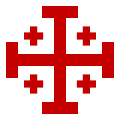
|
Order of the Holy Sepulchre (Militi Sancti Sepulcri) |
Template:Circa | Godfrey of Bouillon | Jerusalem, Latin Kingdom of Jerusalem | 1103 by Baldwin I of Jerusalem 1113 by Pope Paschal II |
Kingdom of Jerusalem to 1291, Custos of the Holy Land: 1230–1489, Pope: 1489- |
Originally an "association" of knights who guarded the Church of the Holy Sepulchre under the jurisdiction of the kings of Jerusalem. In 1113, they became consubstantial with the Canons of the Holy Sepulchre after their recognition by Pope Paschal II, as a military branch, Militi Sancti Sepulcri; after 1291, the Knighthood was awarded to prominent pilgrims by the Custos of the Holy Land.[5] Reorganised as Sacred and Military Order of the Holy Sepulchre in 1496 by Pope Alexander VI. Reorganised by Pope Pius IX with the residential restoration of the Latin Patriarchate of Jerusalem in 1847.[6] Known as the Equestrian Order of the Holy Sepulchre of Jerusalem since 1931. | |
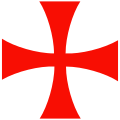
|
Knights Templar (Supreme Order of Christ) (Order Of Christ) |
Template:Circa | Bernard of Clairvaux, Hugues de Payens |
Jerusalem, Latin Kingdom of Jerusalem | 1129 by Pope Honorius II until 1312 by Pope Clement V |
Pope: 1129–1312 | 1312 | The Knights Templar order was reconstituted in Portugal after the Templars were abolished on 22 March 1312 by the papal bull, Vox in excelso, issued by Pope Clement V.[7][8] King Dinis I of Portugal created the Order of Christ (Portugal) in 1317 for those knights who survived their trials throughout Europe and was officially founded in 1319,[9][10][11] The property of the Templars was transferred to the Knights Hospitaller except in the Kingdoms of Castile, Aragon, and Portugal. In effect, causing the dissolution of the Templars by the rival order.[12][13]
Thus when being recognized, the Pope allowing only the "Order Of Christ" a Portuguese order and its Papal branch Supreme Order of Christ can claim to have any descent from the Templars, which is now used for Honorary State merits in Portugal and preserved as such.[12][14][15] |

|
Order of Saint Lazarus (Order of Saints Maurice and Lazarus) |
Template:Circa | Jerusalem, Latin Kingdom of Jerusalem | 1255 by Pope Alexander IV until 1489 by Pope Innocent VIII |
King Fulk of Jerusalem: 1142 Pope: Template:Circa-1572 House of Savoy: 1572- House of France: 1609–1830. |
1489, 1572, 1609, 1830 (1856) |
Italian branch merged 1572 with the Order of Saint Maurice to form the Order of Saints Maurice and Lazarus under the Royal House of Savoy, still extant.
In 1609, King Henry IV of France linked it in France administratively to the Order of Our Lady of Mount Carmel to form the Royal Military and Hospitaller Order of Our Lady of Mount Carmel and Saint Lazarus of Jerusalem united, which remained listed as of royal protection in the French Royal Almanac until 1830.[16] | |
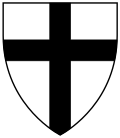
|
Teutonic Knights | Template:Circa | Acre, Latin Kingdom of Jerusalem |
The main stem of the Teutonic Knights converted into a purely Catholic religious order in 1929. The Bailiwick of Utrecht of the Teutonic Order separated from the Roman Catholic mainstem during the time of the Reformation and continues as a Protestant chivalric order.[17] |
National
| Symbol | Name | Founded | Founder | Origin | Recognition | Protection | Extinction | Notes |
|---|---|---|---|---|---|---|---|---|
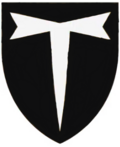
|
Order of Saint James of Altopascio | 1075 (1084) |
Matilda of Tuscany | Altopascio, Tuscany, Holy Roman Empire | 1239–1459, but mentioned in a Papal bull 1198 of Pope Innocent III |
Properties of the hospice of "Altopassus" in Italy confirmed in 1244 by Emperor Frederick II | 1459, 1587, 1672 |
Primarily provided safety and protection to Italian pilgrims to the Holy Land and Camino de Santiago. Merged with the Order of Saint Stephen in 1587 by Pope Sixtus V at request of Grand Duke of Tuscany. In France absorbed into the Order of Saint Lazarus in 1672. |

|
Template:Ill | 1124 | King Alfonso the Battler | Monreal del Campo, Aragon | 1143 1150 |
|||
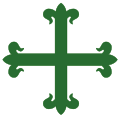
|
Order of Aviz | 1146 (1128) |
Avis, Portugal | Received a grant in 1129 by Theresa, Countess of Portugal House of Aviz: 1385–1580 |
1789 | Secularised 1789. Statutes revised repeatedly together with the other Portuguese orders of merit, during the First Republic (1910–1926), then in 1962, and again in 1986. | ||

|
Order of Saint Michael of the Wing | 1147 (1171) (1828/ 1848/ 1986) |
King Afonso I of Portugal | Santarém, Portugal | First statutes approved in 1171 by Pope Alexander III | House of Braganza: 2001- | 1732 | Abandoned by 1732,[18] restored[19] by King Miguel I in 1828[20] during his brief rule before losing the Liberal Wars to his brother King Pedro IV,[21] revived 1848[19]/1986 [22] |

|
Order of Calatrava | 1158 | Raymond of Fitero | Calatrava la Vieja, Kingdom of Castile, Spain | 1164 by Pope Alexander III | House of Bourbon | 1838 by secularisation | King Charles III of Spain requested old orders to contribute to his new order in his name (1775), which led to dissolution. Confiscated by King Joseph (1808), re-established by Ferdinand VII at the Restoration (1814). Secularised in 1838. |

|
Order of the Holy Ghost | 1161 | Guy de Montpellier | Provence, France | ca. 1161–June 16, 1216 by Pope Innocent III in Santo Spirito in Sassia, Rome | 1692/ 1700/ 20th century |
Historically both religious and chivalric. In 1692 in France, King Louis XIV merged it with his own Order of Our Lady of Mount Carmel. The remaining organisation was edicted in 1700 as purely religious order.[23] Offshoots of the order in France survived into the 20th century. | |

|
Order of Aubrac | 1162 | Aubrac, France | 18th century | Disappeared during the French Revolution in late in the 18th century. | |||

|
Order of Santiago | 1170 | León or Uclés in Castile, Spain | By Papal bull 5 July 1175 by Pope Alexander III | House of Bourbon | |||

|
Order of Alcántara | 1177 | Alcántara, Extremadura, Spain | |||||

|
Order of Mountjoy | 1180 | Holy Land | 1221 | Merged into the Order of Calatrava. | |||
| Order of Truxillo | before 1188 | Trujillo, Cáceres | 1195 | |||||

|
Hospitallers of Saint Thomas of Canterbury at Acre | 1191 | William, Chaplain to the Dean | Acre, and | 1538 | |||

|
Order of Monfragüe | 1196 | 1221 | Merged into the Order of Calatrava. | ||||

|
Order of Sant Jordi d'Alfama | 1201 | 15th century | Early 15th century, merged into the Order of Montesa. | ||||

|
Livonian Brothers of the Sword | 1202 | 1236 | Merged into the Teutonic Order as the Order of Livonia, disbanded 1561. | ||||

|
Order of Dobrzyń | 1216 | Dobrzyń Land, Poland | 1240 | Small number, maximum 35 knights. Battled by the Prussians, around 1235 most knights joined the Teutonic Order. In 1237 the rest of the brothers reinforced Drohiczyn by order of Konrad. Last mentioned when Drohiczyn was captured by Prince Daniel of Kiev in 1240. | |||

|
Militia of the Faith of Jesus Christ | 1221 | 1285 | Note: Symbol that of the Dominican Order. Merged into the Third Order of Saint Dominic. | ||||

|
Order of the Faith and Peace | 1231 | 1273 | |||||

|
Knights of the Cross with the Red Star | 1233 | Agnes of Bohemia | Bohemia | 1237 by Pope Gregory IX Confirmed 1292 by ambassador of Pope Nicholas IV |
Mainly hospitals, in Bohemia still existing. | ||

|
Militia of Jesus Christ | 1233 | Bartolomeo da Vicenza | Parma | 22 December 1234 by Pope Gregory IX. | 1250s | Note: Symbol that of the Dominican Order. Disappeared mid-13th century. | |

|
Order of the Blessed Virgin Mary | 1261 | Loderingo degli Andalò, Catalano dei Malavolti, Ugolino Lambertini | Bologna | 23 December 1261 by Pope Urban IV | 1556 | ||
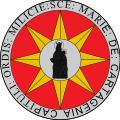
|
Order of Saint Mary of Spain | 1270 | 1280 | Merged into the Order of Santiago. | ||||

|
Order of Montesa | 1317 | ||||||

|
Order of the Knights of Our Lord Jesus Christ (Knights Templar) |
1317 1917 |
Portugal | 1789 1910 |
Secularized 1789. | |||

|
Order of the Dragon | 1408 | Sigismund of Luxemburg | Hungary | 1475s | Active throughout the 15th century in the Balkans[24] | ||

|
Order of Saint Maurice | 1434 | Amedeo VIII of Savoy | Château de Ripaille, Thonon-les-Bains, Savoy | 1572 | Merged with the Order of Saint Lazarus in Italy in 1572 by Pope Gregory XIII into Order of Saints Maurice and Lazarus, considered the legitimate successor of both by the ICOC. | ||

|
Order of the Tower and Sword | 1459 | King Afonso V of Portugal | Portugal | Revived 1808 by Prince Regent John, later John VI of Portugal. Since the end of the monarchy in 1910, all military orders abolished except the Order of the Tower and Sword, with President of Portugal ex officio its Grand Master. | |||

|
Order of Our Lady of Bethlehem | 1459 | Pope Pius II | Lemnos, Byzantine Empire | 18 January 1459 by Pope Pius II | 1460 | Founded in 1453 by Pope Pius II after the Fall of Constantinople to the Ottoman Empire, to defend the island of Lemnos, soon recaptured by the Turks, thus rendered useless and suppressed almost as soon as founded.[25][26] | |

|
Order of Saint George of Carinthia | 1469 | Emperor Frederick III, Holy Roman Emperor | In 1469 by Pope Paul II | Abolished 26 July 1598 (1732?) |
|||
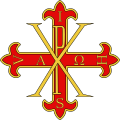
|
Sacred Military Constantinian Order of Saint George | 1522–1545 (1520?)(1550?) |
Angeli Comneni family | Addressed in 1550 by Pope Julius III Cardinal protector in 1910 by Pope Pius X |
Decrees by King Philip III of Spain, Ferdinand II, Holy Roman Emperor on 7 November 1630 | Appears to have been established between 1520 and 1545, with certain statutes dated 1522 by the Angeli Comneni family. Its Grand Master Andrea Angelo Flavio Comneno was addressed first in 1550 by Papal bull Quod Aliasla by Pope Julius III. | ||

|
Order of Saint Stephen Pope and Martyr | 15 March 1561 | Cosimo I de' Medici, Grand Duke of Tuscany | Tuscany | 1 October 1561 by Pope Pius IV | Founded as Benedictine order by Cosimo I de' Medici,.[27][28] dedicated to the martyred Pope Stephen I and the victories at the Battle of Montemurlo in 1537 and the Battle of Marciano (Scannagallo) in 1554. Fought the Ottoman Turks and pirates in the Mediterranean Sea. Abolished in 1859 by the annexation of Tuscany to the Kingdom of Sardinia.[29] Present, Catholic continuation claimed by Archduke Sigismund, Grand Duke of Tuscany.[30][31] |
Other
Chivalric and/or military orders that could qualify depending on definition.
- Confraternity of Belchite, "experimental" confraternity of knights founded in 1122 by King Alfonso the Battler of Aragon
- Order of Saint Blaise, founded in the 12th century in Armenia to defend the country against the attacks of the Muslims
- Knights of the Band, early honorific military order founded c. 1330 by King Alfonso XI of Castile
- Supreme Order of the Most Holy Annunciation, military order founded in 1350 by Duke Amadeus VI, Count of Savoy, the first called the Order of the True Lover's Knots in memory of a bracelet of hair presented to the founder by a lady, but upon the election of Amadeus VIII to the pontificate in 1439, it changed its name for that of the Annunciation of angel Gabriel
- Order of the Dove, short-lived (one year) and controversial order founded in 1379 by King Juan I of Castile
- Order of Saint Anthony (Bavaria), Bavarian military order founded in 1382 by Duke Albert I, Duke of Bavaria
- Military Order of Cross-bearers with the Red Star on a Blue Field, hospitaller and/military order active from the 12th century until suppressed in 1656 by Pope Alexander VII.
- Order of Saint Hubert, early honorific military order founded in 1444 or 1445 by Gerhard VII, Duke of Jülich-Berg
- Blood of Jesus Christ (military order), founded in Mantua, Italy, by Vincenzo I Gonzaga, Duke of Mantua, approved on 25 May 1608 by Pope Paul V
- Template:Ill, founded in 1261 by King Ferdinand III of Castile[32]
- Order of the Hatchet female spanish military order during the middle ages.
Modern development
A few of the institutions survived into honorific and/or charitable organizations, including the papal orders of knighthood.
While other contemporary Catholic societies may share some military organizational features and ideology, such as the Society of Jesus,[33] they differ from the medieval military orders in the absence of military purposes or potential.
Modern orders may still be founded explicitly as a military order; the Military Order of Loyalty (Template:Langx) was founded in 1946 by the Spanish protectorate in Morocco. Awarded to both Spanish and Moroccan military officers and soldiers, the single-class order was abolished in 1956.
See also
References
- ↑ {{#invoke:citation/CS1|citation |CitationClass=book }}
- ↑ {{#invoke:citation/CS1|citation |CitationClass=book }}
- ↑ Template:Cite web
- ↑ Michael Jones ed., The New Cambridge Medieval History, vol. 6: c. 1300 - c. 1415, (Cambridge, 1998), p. 209.
- ↑ D'Assemani, Michael H Abraham,The Cross on the Sword, A History of the Equestrian Order of the Holy Sepulchre of Jerusalem ,1944.
- ↑ Template:Cite web
- ↑ {{#invoke:citation/CS1|citation |CitationClass=book }}
- ↑ {{#invoke:citation/CS1|citation |CitationClass=book }}
- ↑ Template:CathEncy
- ↑ {{#invoke:citation/CS1|citation |CitationClass=book }}
- ↑ {{#invoke:citation/CS1|citation |CitationClass=book }}
- ↑ 12.0 12.1 José Vicente de Bragança, The Military Order of Christ and the Papal Croce di Cristo
- ↑ Martin, pp. 140–142.
- ↑ Template:Cite web
- ↑ {{#invoke:citation/CS1|citation |CitationClass=book }}
- ↑ Moeller, Charles. "The Military Orders." The Catholic Encyclopedia Template:Webarchive Vol. 10. New York: Robert Appleton Company, 1911. 22 Jun. 2015
- ↑ {{#invoke:citation/CS1|citation |CitationClass=book }}
- ↑ {{#invoke:citation/CS1|citation |CitationClass=book }}
- ↑ 19.0 19.1 {{#invoke:citation/CS1|citation |CitationClass=book }}
- ↑ {{#invoke:citation/CS1|citation |CitationClass=book }}
- ↑ {{#invoke:citation/CS1|citation |CitationClass=book }}
- ↑ Template:Cite web
- ↑ Orders of the Holy Ghost Template:Webarchive - Catholic Encyclopedia article
- ↑ {{#invoke:citation/CS1|citation |CitationClass=book }}
- ↑ Besse, Jean. "Bethlehemites." The Catholic Encyclopedia Template:Webarchive Vol. 2. New York: Robert Appleton Company, 1907. 23 Jun. 2015
- ↑ Trollope, Thomas Anthony. An encyclopædia ecclesiastica, 1834
- ↑ Template:Cite EB1911
- ↑ {{#invoke:citation/CS1|citation |CitationClass=book }}
- ↑ {{#invoke:citation/CS1|citation |CitationClass=book }}
- ↑ {{#invoke:citation/CS1|citation |CitationClass=book }}
- ↑ {{#invoke:citation/CS1|citation |CitationClass=book }}
- ↑ {{#invoke:citation/CS1|citation |CitationClass=book }}
- ↑ Harro Höpfl (2004), Jesuit Political Thought: The Society of Jesus and the State, c. 1540–1630, Cambridge; p. 25
Bibliography
- {{#invoke:citation/CS1|citation
|CitationClass=book }}
- Nicholson, Helen J. The Knights Hospitaller (2001).
- Riley-Smith, Jonathan. Hospitallers: The History of the Order of St John (1999).
- Morten, Nicholas Edward. The Teutonic Knights in the Holy Land 1190-1291 (Woodbridge: Boydell Press, 2009)
- Forey, Alan John. The Military Orders: From the Twelfth to the Early Fourteenth Centuries. *(Basingstoke: Macmillan Education, 1992)
- {{#invoke:citation/CS1|citation
|CitationClass=book }}
Template:Orders Template:Crusader sites Template:Crusader states Template:Latin Church footer Template:Orders, decorations, and medals of the Holy See Template:History of the Catholic Church {{#invoke:navbox|navbox | name = Catholic Church footer | title = Catholic Church | basestyle = background-color:gold | titleclass = wraplinks | bodyclass = hlist wraplinks | state = autocollapse | above =
| group1 = History
Timeline
Ecclesiastical
Legal
| list1 =
{{#invoke:navbox|navbox|subgroup |groupwidth= 12em | basestyle = background-color:gold | group1 = Early Church | list1 =
| group2 = Great Church | list2 =
- Ante-Nicene period
- Constantine
- First seven ecumenical councils
- Late antiquity
- Biblical canon
- Monasticism
| group3 = Middle Ages | list3 =
- Islamic conquests
- Pope Gregory I
- Papal States
- Schism (1054)
- Investiture Controversy
- Crusades
- Schism (1378)
- Inquisition
- Universities
- Scholasticism
- Age of Discovery
| group4 = Modern era | list4 =
- Protestantism
- Thirty Years' War
- Enlightenment
- French Revolution
- Nazism
- Vatican II
- Communism
- Sexual abuse scandal
- Islam
- COVID-19 pandemic
}}
| group2 = Theology
Bible
Tradition
Catechism
| list2 =
{{#invoke:navbox|navbox|subgroup |groupwidth= 12em | basestyle = background-color:gold | group1 = General | list1 =
- God
- Body and soul
- Divine grace
- Dogma
- Nicene Creed
- Original sin
- Saints
- Salvation
- Sermon on the Mount
- Ten Commandments
- Vulgate
- Official Bible
- Worship
| group4 = Ecclesiology | list4 =
- Communitas perfecta
- Councils
- Ecumenism
- Four marks
- Infallibility
- Mystici Corporis Christi
- People of God
- Three states
- Subsistit in
- In canon law
| group5 = Sacraments | list5 =
| group6 = Mariology | list6 =
- Assumption
- History
- Immaculate Conception
- Mariology of the popes
- Mariology of the saints
- Mother of God
- Perpetual virginity
- Veneration
- See also:
- Josephology
}}
| group3 = Philosophy | list3 =
- Natural law
- Moral theology
- Personalism
- Social teaching
- Philosophers
- Philosophy of canon law
- See also:
- Science
- Separation of church and state
| group4 = Saints | list4 =
- Holy Family
- Patriarchs
- Prophets
- Archangels
- Martyrs
- Doctors of the Church
- Evangelists
- Confessors
- Disciples
- Virgins
| group5 = Organisation
Hierarchy
Canon law
Laity
Precedence
By country
| list5 =
{{#invoke:navbox|navbox|subgroup
|groupwidth= 12em
| basestyle = background-color:gold
| group1 = Holy See
(List of popes)
| list1 =
- Pope Template:Incumbent pope
- Ecumenical councils
- College of Cardinals
- Roman Curia
- Synod of Bishops
- Properties
| group2 = Vatican City | list2 =
- Index
- Outline
- Apostolic Palace
- Lateran Treaty
- Roman Rota
- St. Peter's Basilica
- Swiss Guard
- Vatican Museums
| group3 = Polity (Holy orders) | list3 =
| group4 = Consecrated life | list4 =
| group5 = Particular churches
sui iuris
| list5 =
| group6 = Catholic liturgy | list6 =
}}
| group6 = Culture | list6 =
- Art
- Artists
- Writers
- Church buildings
- Folk
- Library
- Museums
- Music
- Distinctions
- Role in civilisation
- See also:
- Criticism of the Catholic Church
- Anti-Catholicism
| group7 = Media | list7 =
- Holy See Press Office
- Vatican Media
- Template:Interlanguage link
- L'Osservatore Romano
- Acta Apostolicae Sedis
- Annuario Pontificio
| group8 = Religious orders,
institutes, societies
| list8 =
- Assumptionists
- Annonciades
- Augustinians
- Basilians
- Benedictines
- Bethlehemites
- Blue nuns
- Camaldoleses
- Camillians
- Carmelites
- Carthusians
- Cistercians
- Clarisses
- Conceptionists
- Crosiers
- Dominicans
- Franciscans
- Good Shepherd Sisters
- Hieronymites
- Jesuits
- Legionaries
- Mercedarians
- Minims
- Olivetans
- Oratorians
- Piarists
- Premonstratensians
- Redemptoristines
- Servites
- Theatines
- Trappists
- Trinitarians
- Visitandines
| group9 = Associations
of the faithful
| list9 =
- Confraternities
- Third orders
- Military orders
- Fimcap
- Catholic Action
- Charismatic Renewal
- Communion and Liberation
- Sant'Egidio
- Focolare
- International Alliance of Catholic Knights
- Scouting
- Legion of Mary
- Neocatechumenal Way
- Opus Dei
- Schoenstatt
| group10 = Charities | list10 =
- Aid to the Church in Need
- Caritas
- Catholic Charities USA
- Home Missions
- Relief Services
- CIDSE
- Pax Christi
- Society of Saint Vincent de Paul
- See also:
- Health care
- Schools
- Universities
| below =
}}